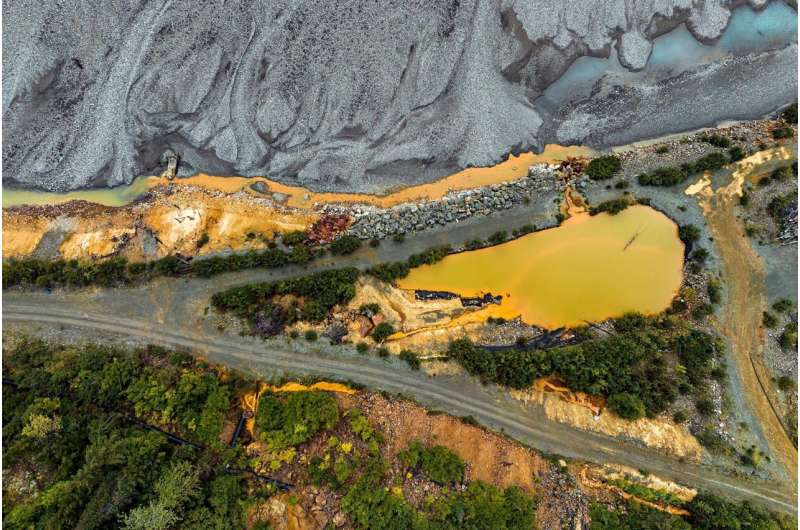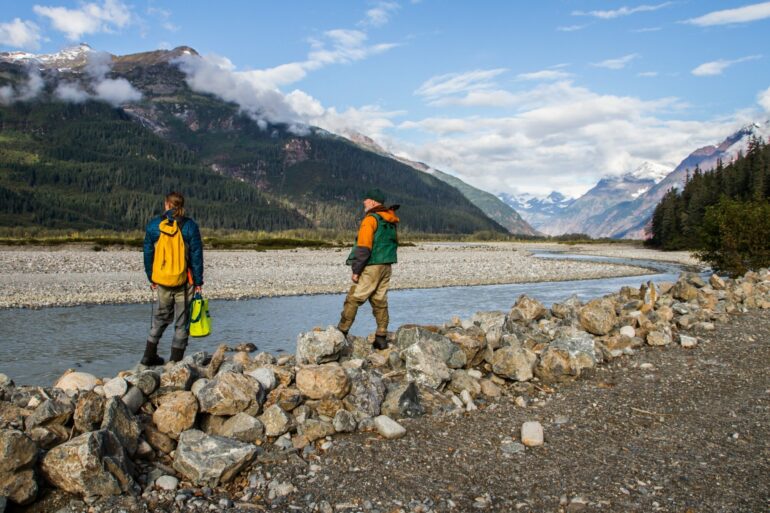A study led by Simon Fraser University researchers finds that mining companies are staking claims on future salmon habitats as glaciers retreat.
In the ice-covered transboundary region shared by northern B.C. and Alaska, glacier retreat is creating thousands of kilometers of new rivers that salmon are finding. These emerging rivers represent future habitats for salmon but mining companies are also looking to these areas for the next gold mine.
A new study published in Science maps out these emerging land use conflicts and identifies policy blind spots as well as key opportunities for the stewardship of these nascent habitats.
The paper discovered that of the 114 subwatersheds in the transboundary region with future salmon habitat, 25 had more than 50% of future salmon habitat near a mining claim. In addition, more than half of future salmon habitat in Canada has either medium or high mineral potential, an indicator of future potential mining pressure.
The paper was a collaboration among researchers from SFU, Gitanyow First Nation Hereditary Chiefs, the University of Montana Flathead Lake Biological Station, and Taku River Tlingit First Nation.
“Climate change and other human activities are harming salmon populations in much of their range. Yet in some locations of northern B.C. and Alaska, glacier retreat is creating hotspots of opportunity for salmon, but also of mining pressure. This is an emerging environmental issue,” says SFU professor Jonathan Moore, the study’s lead author and head of the Salmon Watersheds Lab.
This study builds on previous work by Moore and Kara Pitman, a research scientist at SFU. “Previously, we mapped where and when future salmon habitat would be created with glacier retreat. This builds on that work, and is the first time that we have assessed where mining claims or mineral potential overlap with future salmon habitats,” says Pitman.
B.C. mining policy in reform
The Mineral Tenure Act is the B.C. policy that allows mining companies to stake claims on lands with minimal government oversight and without consultation with First Nations. The B.C. Supreme Court recently ruled that the Mineral Tenure Act violated the duty to consult with First Nations rightsholders, and ordered the Province to modernize the Act in the next year and a half.

An abandoned mine on the banks of the Tulsequah River, BC, Canada. © Chris Miller
“These changes can’t come soon enough,” says Tara Marsden, with Gitanyow Hereditary Chiefs, a study co-author. “The Mineral Tenure Act not only violates Indigenous rights but also undermines stewardship of ecosystems for future generations.”
Environmental policies for climate resilience
The paper also illuminates a broad global challenge—as climate change is rapidly transforming the world, environmental policies may struggle to keep pace. For example, risk assessments and habitat protections by current environmental laws generally focus on the current values of ecosystems, but not their future values.
“Climate change is transforming ecosystems around the world,” says Moore. “Even as there is urgent need to take global action on climate change, this paper also reveals the need to look carefully at environmental laws and make sure that they not only protect habitats of today, but also the habitats of tomorrow.”
Indigenous-led stewardship of changing watersheds
The region is also at the forefront for Indigenous rights and reconciliation. Different First Nations are advancing Indigenous Protected Areas and land-use plans that are forward-looking, incorporating climate change and holistic perspectives into environmental stewardship.
Marsden noted, “Our Ayookxw, our Gitanyow laws, speak to our obligations to future generations. We are seeing changes in our Lax’yip, our territories, and we are taking action to protect our ecosystems even as they change. Our policies consider climate change, and our new Indigenous Protected Area is in response to salmon finding new habitats as glaciers retreat.”
The paper speaks to the broad opportunity for proactive conservation that advances Indigenous rights.
“With our land-use plans and protections, we are not saying no to industry everywhere, we are saying let’s do this is a good way,” says Marsden. “This is a globally relevant opportunity to get a lot right—Indigenous rights, meaningful protection of biodiversity and ecosystems, and climate resilience.”
More information:
Jonathan W. Moore et al, Mining stakes claim on salmon futures as glaciers retreat, Science (2023). DOI: 10.1126/science.adj4911
Provided by
Simon Fraser University
Citation:
Mining industry competing with salmon for rivers created by disappearing glaciers (2023, November 24)



